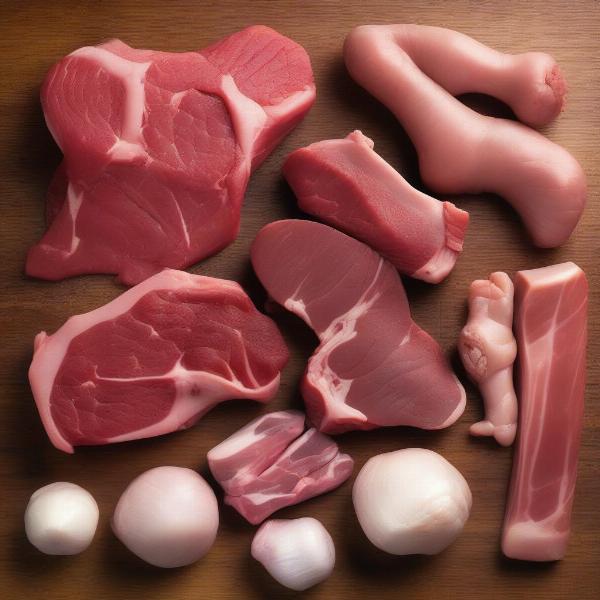Raw beef dog food has gained popularity among dog owners seeking a more natural diet for their canine companions. But is it the right choice for your dog? This comprehensive guide will explore the benefits, risks, and essential considerations of feeding your dog a raw beef-based diet. We’ll cover everything from nutritional needs to safe handling practices, helping you make an informed decision about your dog’s dietary needs.
Understanding the Basics of Raw Beef Dog Food
A raw beef diet for dogs typically consists of uncooked beef, including muscle meat, organs, and bones. Proponents believe it mimics a dog’s ancestral diet, offering potential benefits like improved digestion, shinier coat, and increased energy. However, it’s crucial to understand both the potential advantages and disadvantages before switching your dog to a raw food diet.
 Raw Beef Dog Food Ingredients
Raw Beef Dog Food Ingredients
Nutritional Benefits and Risks of Raw Beef
Beef is a rich source of protein, essential amino acids, and vitamins like B12 and iron. These nutrients are crucial for muscle development, energy production, and overall health. However, feeding exclusively raw beef can lead to nutritional imbalances. Dogs require a variety of nutrients, and a diet solely based on beef may lack essential vitamins, minerals, and fatty acids.
It’s important to note that raw beef carries a risk of bacterial contamination, such as Salmonella and E. coli. These bacteria can pose a health risk to both dogs and humans handling the raw meat. Proper hygiene practices, such as thorough handwashing and sanitizing surfaces, are essential to minimize these risks.
“A balanced raw diet requires careful planning and supplementation to ensure it meets a dog’s complete nutritional needs,” says Dr. Emily Carter, DVM, a veterinary nutritionist with over 15 years of experience.
Preparing Raw Beef Dog Food Safely
If you choose to feed your dog raw beef, it’s vital to source high-quality meat from reputable butchers. Avoid ground beef, which has a higher risk of bacterial contamination. Always handle raw meat with care, washing your hands thoroughly before and after preparation.
Freezing the beef for a few days before feeding can help reduce the bacterial load, but it won’t eliminate all risks. Never thaw raw meat at room temperature, as this can promote bacterial growth. Instead, thaw it in the refrigerator.
Transitioning Your Dog to a Raw Beef Diet
If you’re considering switching your dog to a raw beef diet, it’s crucial to do so gradually. Sudden dietary changes can upset a dog’s digestive system, leading to vomiting and diarrhea. Start by introducing small amounts of raw beef alongside your dog’s current food, gradually increasing the proportion of raw beef over several weeks.
Monitor your dog closely during the transition and consult with your veterinarian if you notice any digestive issues or changes in their health. They can help you assess your dog’s individual needs and recommend appropriate supplements to ensure a balanced diet.
Conclusion
Raw beef dog food can be a viable option for some dogs, but it’s essential to approach it with caution and careful consideration. Understanding the potential benefits and risks, practicing safe handling procedures, and ensuring nutritional balance are crucial for your dog’s well-being. Consult with your veterinarian before making any significant dietary changes for your furry friend. They can provide personalized guidance and help you determine if a raw beef diet is the right choice for your dog’s individual needs.
FAQ
- Is raw beef safe for puppies? While puppies can be fed raw diets, their immune systems are still developing, making them more susceptible to bacterial infections. Consult with your veterinarian before feeding raw beef to a puppy.
- Can I mix raw beef with kibble? Mixing raw and kibble isn’t recommended, as they digest at different rates and can lead to digestive upset.
- How do I ensure my dog gets enough calcium on a raw beef diet? Including ground bone or bone meal in the diet can help provide sufficient calcium.
- What are the signs of bacterial contamination in raw beef? Signs of spoiled meat include a foul odor, slimy texture, or discoloration.
- How often should I feed my dog raw beef? Most adult dogs thrive on one to two meals per day.
- What are some alternatives to raw beef for a raw diet? Other raw protein sources include chicken, turkey, fish, and lamb.
- Is raw beef more expensive than commercial dog food? Raw diets can be more expensive, especially if you use high-quality ingredients and supplements.
Related Articles:
pork shoulder bone dog
least expensive raw dog food
savourlife dog food 20kg
dog food nz
About ILM Dog:
ILM Dog provides expert advice and resources on all aspects of dog care, from breed selection and nutrition to training and health. We are committed to helping dog owners worldwide make informed decisions to ensure their canine companions live long, happy, and healthy lives. Our expertise covers a range of topics including nutrition and feeding. Contact us for personalized guidance: Email: [email protected], Phone: +44 20-3965-8624.